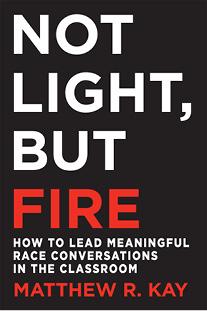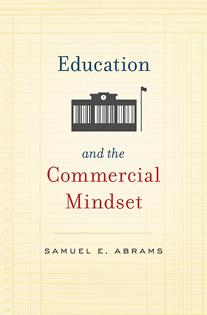Not Light, But Fire: How to Lead Meaningful Race Conversations in the Classroom
For teachers who want to engage students in important yet difficult discussions about race, but who feel unsure how to go about it, a book by a fellow educator may offer some help. Not Light, but Fire: How to Lead Meaningful Race Conversations in the Classroom (Stenhouse), by Matthew R. Kay, offers ways to approach the topic of race in order to strengthen classroom communities and shape the next generation of thoughtful citizens.
A public school teacher in Philadelphia, Kay opens his book with an eloquently written introduction in which he explains the book’s title. The phrase comes from an anti-slavery speech that Frederick Douglass, the former slave and great American statesman, gave in 1852. In his address, Douglass argued that in discussions of race, “It is not light that is needed, but fire.” Kay writes that “Douglass knew what many are noticing now: that we never seem to graduate to the next conversation. The hard one.” For such conversations to be authentic and to result in progress, Douglass metaphorically called for them to be infused with fire.
The metaphor holds particular meaning for Kay. As a teacher of English, he deeply appreciates language. And as a teacher of color, he knows firsthand our country’s struggles with racism.
To lay the foundation for these conversations at the Science Leadership Academy, where he teaches high school students from diverse backgrounds, Kay ensures they listen patiently, listen actively, and police their voice. All three behaviors entail students truly hearing what their classmates say, speaking succinctly when it’s their turn to speak, and making eye contact with their classmates—not just with him, their teacher—during discussions.
Throughout the book, Kay references texts that educators have long relied on to raise issues of race in the classroom. These include Roll of Thunder, Hear My Cry; To Kill a Mockingbird; and Adventures of Huckleberry Finn. Such works have long been rightfully part of the curriculum. But he encourages English language arts teachers to cast a wider net. For instance, they could add to their syllabi the murder mysteries of Walter Mosley, the science fiction of Octavia Butler, and the novels of Chimamanda Ngozi Adichie. These works, which feature characters of color, “present a more layered idea of race and culture,” an idea crucial for all students, no matter their color, to understand. Although discussing racism is absolutely necessary, Kay makes this key point: “We should push, with equal energy, against the trend to make struggle-against-white-people stories the only stories we discuss.”
Education and the Commercial Mindset
In recent years, several books have been published that explore the corporate influence on public education. Few are as in depth and as evenhanded as Education and the Commercial Mindset (Harvard University Press) by Samuel E. Abrams. A former high school teacher in New York City, Abrams chronicles the push to privatize K–12 education and explains how some, but not all, business practices inevitably distort education policy.
Currently the director of the National Center for the Study of Privatization in Education at Columbia University’s Teachers College, Abrams first focuses on the growth of educational management organizations (EMOs), private companies hired to run public schools. The brainchild of economist Milton Friedman, the father of school vouchers, EMOs gained ground in the 1990s and early 2000s by winning lucrative contracts to turn around low-performing schools in low-income areas.
“They were education’s answer to health maintenance organizations, or HMOs, likewise dedicated to improving service, containing costs, and, in many cases, making a profit,” Abrams writes. But they were hardly successful. In particular, he recounts the rise and fall of one such for-profit enterprise, Edison Schools Inc. In a chapter tellingly titled “Waterloo,” he explains how schools that the company managed in Baltimore and Philadelphia saw increases in behavior problems and truancy rates and decreases in student achievement.
He then contrasts Edison’s trajectory with those of two nonprofit charter networks, KIPP and Mastery Charter Schools. Abrams explains why KIPP and Mastery have largely succeeded where Edison failed, and he lauds both for doing “great work despite the force of poverty.” However, he does not argue that charters can improve all of public education. “Their dependence on a finite supply of generous philanthropists, tireless teachers, and students as well as families capable of abiding by rigid academic and behavioral expectations limits their reach,” he writes.
What he says is needed is greater investment in public schools, which are responsible for educating all students. To that end, Abrams suggests transforming them into community schools with wraparound services for students and families.
What has prevented such a transformation? That “much of our mistaken thinking about education policy derives from our commercial mindset.” To illustrate his point, he devotes the final two chapters to how Finland has vastly improved its education system by investing in it, unlike Sweden, which has devoted considerable resources to building a system of vouchers. Focusing on teacher training and increasing teacher pay are “signature lessons from the business world,” Abrams writes. If only policymakers in the United States would learn to apply them.


